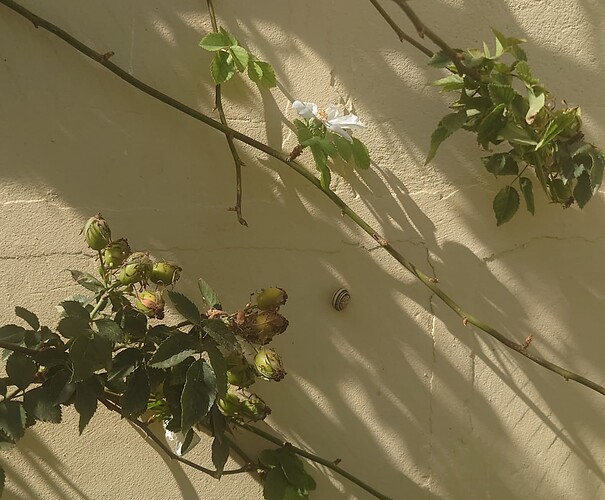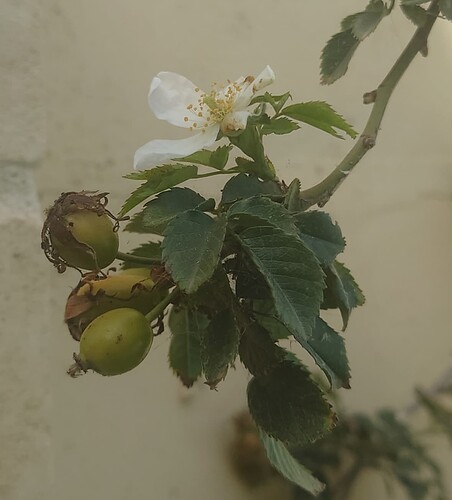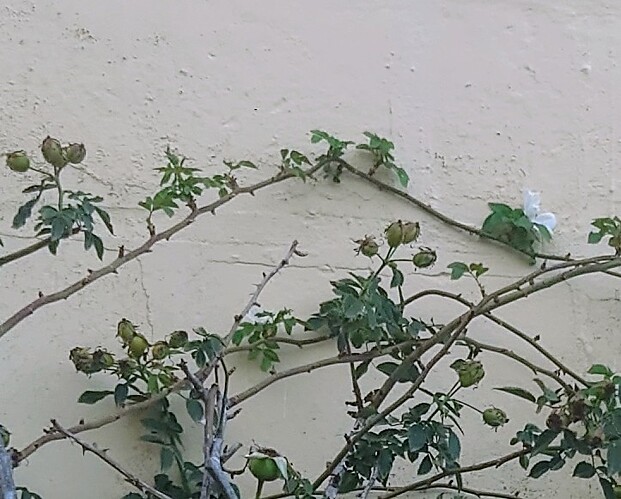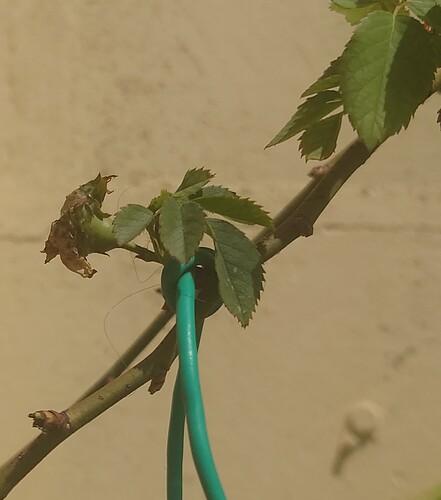We discussed this rose briefly in another thread regarding alkaline soil tolerance.
In my boyfriend’s garden, there are two giant old plants of laxa rootstock that have totally overtaken whatever roses the owner had once planted. I usually ignore them, but have been paying closer attention to them this year since I’d like to use the seeds to try and grow some rootstock and learn to graft.
Yesterday I went over there to have a look at the developing hips, and I noticed that one of the two Laxas was reblooming.
Not a huge flush, but still about 10 blooms, all of them laterals, and a few more buds starting to form. The spring flush was months ago, and there hasn’t been any blooming since.
I had no idea that the laxa used as rootstock had the ability to rebloom. HMF says it’s once-blooming. I wonder if rebloom might be something that happens only in very mature plants?
Now I am thinking of using the reblooming plant’s pollen for some crosses if it can be passed on. There’s not a lot to work with, but it might be worth trying. I’ll see if I can find something to put the pollen on. I see it’s a pentaploid. I’ve never used that. Any suggestions about a seed parent ploidy that might be better for this?
Also, I wonder if the rebloom would be passed on in plants grown from the earlier hips of this plant, or if I might have a better chance of getting it to pass on by using OP hips from these July blooms?
A few pics, sorry the last one is blurry!
Could be. Some other canina do rebloom, but very rarely. There are sources - pictures and all - that show wild R. rubiginosa reblooming, very much in the way your pictures are showing.
‘Laxa’ would be R. corymbifera ‘Laxa’, a variety of a species from section Caninae. Having little ‘thorns’ and resembling a dogrose in many ways, but with white or very pale pink flowers.
You live in a Mediterranean climate?
Yes @KarelBvn , you are correct, it’s Corymbifera laxa, that’s the one I mean. Sorry I should have specified that in my OP. At least I am guessing it is, since that’s the default rootstock here, and the size, foliage, blooms and hip shape seem to match. She is very low-thorn and the flowers are white (rarely slightly blushed).
Indeed, I am in Malta, which is about as Mediterranean as it gets! Currently experiencing a sweltering heatwave. Hope it’s cooler where you are.
I’d really like to try to get something out of these midsummer blooms, especially if there’s any chance the remontancy could be passed on. Any suggestions would be welcome!
Heard it’s is quite hot in southern Europe and below. Courage.
It is canina. So you’ll have the canina-meiosis. Wouldn’t recommend using it as a seedparent. As pollen parent it would act as a diploid. But still, the remontancy - in my opinion - is probably not a true one, but something eventual. Maybe due to the heat or something else.
Of course I’m hoping it works. Maybe with a Rugosa or R. moschata?
Since the pollen will only carry one set of chromosomes, it may be most likely to succeed in pollinating a diploid (or a member of Caninae). I’m not sure if unreduced pollen also occurs at a low frequency in Caninae species as it seems to do in most other plants.
The correct name for R. coriifolia is R. caesia:
Stefan
I see it the same way as KarelBvn. Also with Spinosissimas and their hybrids I could observe from time to time a slightly sporadic, repeating flowering due to hot temperatures or other weather influences. There is probably no real genetic basis for remontancy in either case.
Thank you @Roseus, @KarelBvn and @MidAtlas for sharing your insight on this rose !
You are most probably right that this is not inheritable and just a sporadic oddity due to weather or some other factor. Last year I wasn’t paying any attention to these roses so I don’t know if the rebloom happened then or not.
I’m a little puzzled about why only one of the two plants of this variety is doing it, when there isn’t really any difference in their growing conditions: they both bake all day against a south-facing wall, about 4 meters apart from each other.
I’ll try putting pollen from a few of the July flowers onto Will Alderman and perhaps Mutabilis since they’re my only currently blooming diploids.
The rest I am going to leave on the bush and allow to OP (there are no other roses in bloom close to them, so I suppose these will be selfs). I have tagged all the blooms from this surprise flush so I can collect any hips from them separately from the rest. If any of these OP pass on rebloom I will report it here, but I am not counting on it. Most likely I will just end up with more of this rootstock than I anticipated!
More blooms today!
Current temps are around 30°c.
Only two blooms, but I 'm amazed she’s still at it in September. Sorry for the poor quality picture but that bloom is really high up.
My attempts at using her pollen on Mutabilis, Will Alderman and Marie Pavie in July all failed.
Also in July, I wasn’t going to use Corymbifera Laxa as a seed parent, but at the last minute I thought heck why not and dabbed some Augusta Luise onto her, and one in four appears to have taken. A small hip, but it’s there.
This morning when I saw she had new blooms, all I had on hand was Eyes for You. So I used that, without emasculating because they are way too high up and all I could do was reach up and smother the center as best I could with a thick coat of EfY pollen.
When the temps cool down a bit I will try to take some cuttings from this plant. All the rebloom has been on this one, while the other Corymbifera Laxa next to her hasn’t had any at all. I will harvest only the OP hips from the reblooming one, not her neighbor… If there’s any chance this could be passed on, I want to try and find out!
An interesting experiment! I hope and cross my fingers for you that it somehow succeeds and the reblooming genes remain stable and perceptible.
I have never had experience with it but what about ‘Stanwell Perpetual’ it’s half spinossisima and reblooming there are genes involved not just environment.
I have most of my blooming in fall on Rosa altaica when it has become quite cold.
Has anyone studying this somewhat different rebloom.
Wild Canina does not rebloom here. However, I have had autumn echo bloomers with a Glutinosa hybrid and a Canina hybrid. Its usually sparse and brief. Both hybrids were with tetraploid modern roses as the male parent.




